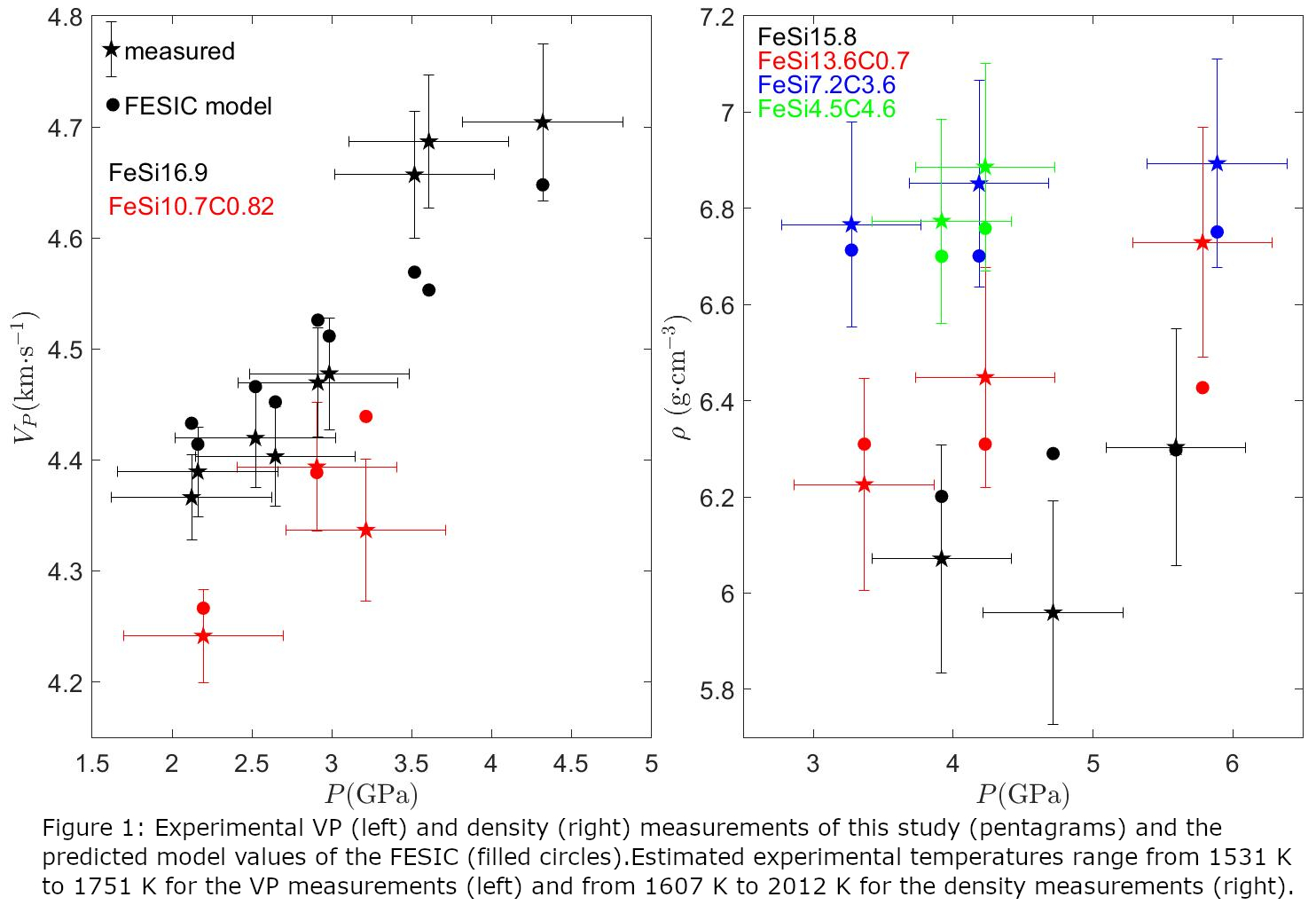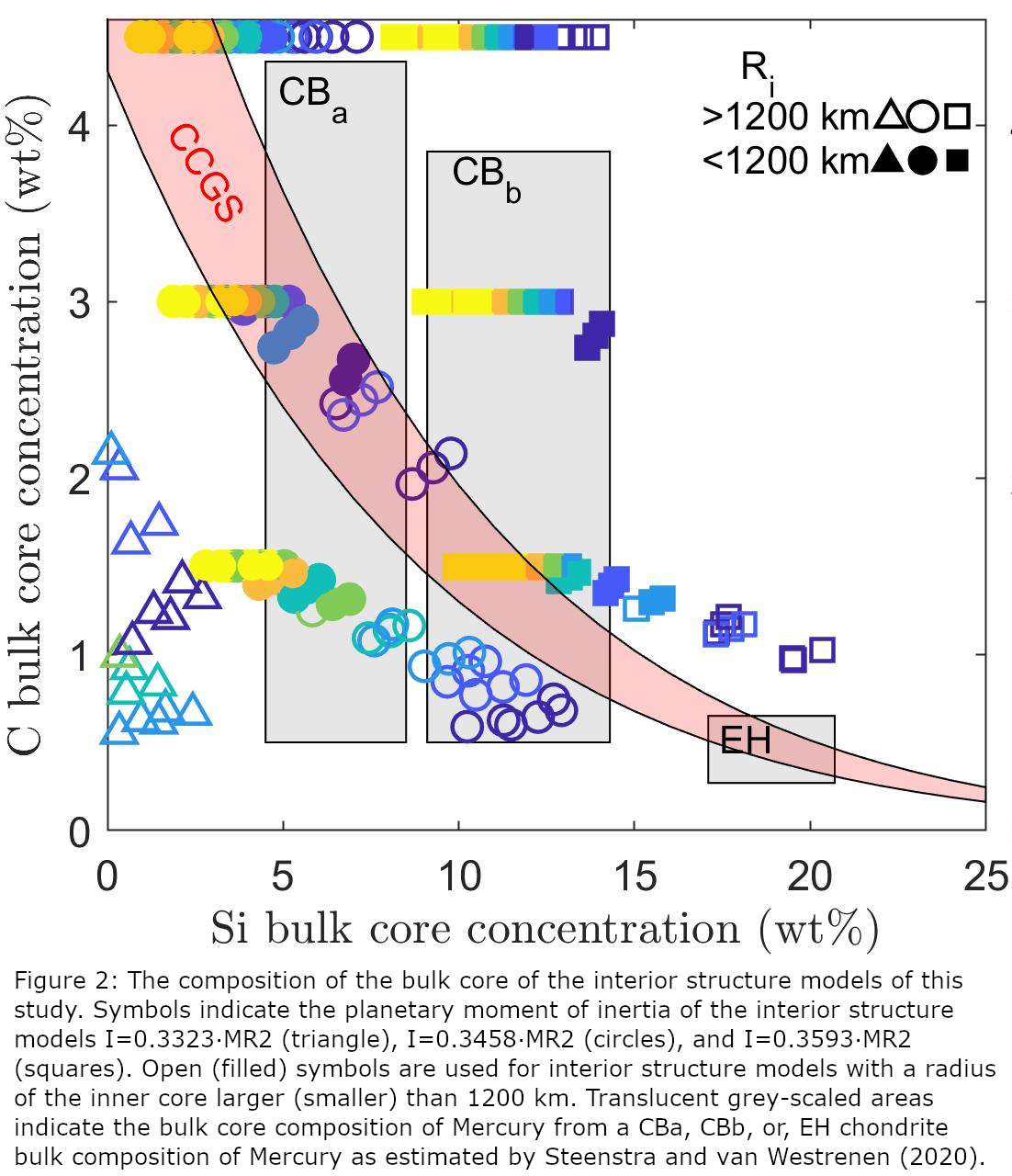Mercury’s Interior Structure constrained by Density and P-wave Velocity Measurements of Liquid Fe-Si-C Alloys
- 1Royal Observatory of Belgium, Ukkel, Belgium (jurrien.knibbe@oma.be)
- 2Faculty of Science, VU University Amsterdam, Amsterdam, the Netherlands.
- 3Department of Earth and Environmental Sciences, KU Leuven, Leuven, Belgium
- 4Department of Geology, University of Liège, Liege, Belgium
- 5European Synchrotron radiation Facility (ESRF), Grenoble, France
- 6Institute for Mineralogy, Westfälische Wilhelms-Universität Münster, Münster, Germany
- 7Geodynamics Research Center, Ehime University, Ehime, Japan
- 8Institut de physique du globe de Paris, Université de Paris, CNRS, Géomatériaux, Paris, France
Introduction
In light of the low oxygen fugacity inferred for Mercury, it is expected that Si is the dominant light constituent of Mercury’s core, potentially combined with smaller amounts of C and S. Depending on specific assumptions on Mercury’s oxidation state and bulk composition (for example, assuming a CB or EH chondrite-like bulk composition), geochemical estimates for the amount of Si, C, and S in Mercury’s core differ [1,2]. The concentration of light elements in Mercury’s core can be assessed independently from geochemical inferences using geophysical measurements. Geodetic constraints on the interior mass distribution of Mercury are derived from Mercury’s (close proximity to a) Cassini state 1 [3]. The compositional range of Mercury’s core for which the mass distribution of the planet is in agreement with geodetic measurements can be examined by planetary interior structure modelling [4-6]. Such interior structure modelling requires a composition-dependent parametrisation of the thermodynamic properties of metallic core alloys. Experimental measurements of density and of ternary Fe-Si-C liquids at high pressures have been lacking, although they are crucial to constrain the compositional range of Mercury’s core, and of bulk Mercury, using geodetic information of the planet.
We experimentally measured the density and P-wave velocity (VP) of Fe-Si-C liquid metallic mixtures at high pressure, and investigated the feasible range of Mercury’s core composition in light of present geodetic constraints by interior structure modelling.
Methods
Density measurements of Fe-Si-C liquid metals are performed at high-pressure and high-temperature by X-ray absorption techniques with a Paris-Edinburgh (PE) press at beamline ID-27 of the European Synchrotron Radiation Facility (ESRF) in Grenoble, France. Binary Fe-Si sample powder is loaded into a cylindrical diamond (C) sample container, which saturates the sample in C. X-ray absorption profiles of the C-saturated Fe-Si-C metallic liquid sample are obtained in-situ, and of the quenched sample after the experiment ended and brought to ambient conditions. The density of the recovered samples is measured by hydrostatic weighing at the IPGP in Paris, France. The density of the liquid sample at experimental conditions is derived by combining the density of the quenched sample and the post-situ X-ray absorption profile with the in-situ X-ray absorption profile, using the Beer-Lambert law for X-ray absorption.
Ultrasonic VP measurements of Fe-Si liquid metals are performed at high-pressure and high-temperature with a PE press at beamline 16-BMB of the Advanced Photon Source (APS) synchrotron facility, in Argonne, Illinois. Ultrasonic signals of 20 MHz, 25 MHz, and 30 MHz are generated and received in-situ by a lithium niobite transducer located at the top of the setup. Vertical wave reflections at the top and at the bottom of the sample are recorded and used to determine the vertical two-way travel time of the ultrasonic wave through the sample. The sample length is determined from radiographic images that are collected in situ. The ultrasonic sound speed (VP) through the sample is calculated using the sample length and the two-way travel time of sound waves.
The samples that are successfully recovered from both the density experiments and the VP experiments are analysed by electron microprobe at the Institute for Mineralogy in Münster, Germany. A ternary ideal mixing model (FESIC) is fitted to the Fe-Si-C liquid metal density and data obtained by us and to data available in literature. This mixing model is implemented in spherically symmetric interior structure models of Mercury that are constrained by the normalized moment of inertia of Mercury I=0.346±0.014 MR2 and that of its outer solid shell Im=0.1475±0.006 MR2 [3]. The thermal profile is taken linear in the upper part (assumingly conductive) of the core, and adiabatic lower in the core. An Fe-Si-C solid inner core is considered where temperature is below the melting temperature of the liquid alloy. The mantle and an assumed 40 km thick curst are parametrized as single density spherical shells with fixed density ratio.
Results

Figure 1 compares the obtained density and VP measurements with the FESIC mixing model. The results confirm previous studies that VP of Fe-rich liquid metal increases and the density decreases with increasing concentration of Si. For the C-saturated density measurements, the decrease of C with increasing Si concentration confirms that the solubility of C in Fe-Si metals decreases with increasing concentration of Si. In the VP experiments, the sample was not loaded in a C-saturated environment. Nonetheless, we did detect a small amount of C in the sample with ~10wt%Si.

The bulk-core compositions of interior structure models, constrained by the I and Im mentioned above, are compared to estimated core composition from by geochemical methods [1] from assuming a bulk composition of Mercury similar to an EH chondrite or CB chondrites (figure 2). The Si and C concentrations of Mercury’s core that are estimated from assuming a CB-like bulk composition of Mercury are consistent with the core composition of interior structure models with the central value of I (0.3458·MR2). A EH chondrite-like bulk composition of Mercury is thought to have a large core concentration of Si, and can only be met with an obliquity of Mercury at the upper end of the uncertainty limit, the planet is cold, and the inner core is large. The latter is inconsistent with the deep-dynamo explanation for Mercury’s broad-scale low-intensity magnetic field [7]. This study is published and openly accessible [8].
Acknowledgements
We acknowledge the Marie Sklodowska-Curie grant No 845354 awarded to JSK and the BRAIN-be program grant (BR/143/A2/COME-IN) to TVH. The X-ray absorption measurements were performed at the European Synchrotron Radiation Facility (ESRF), Grenoble, France. The APS is operated by Argonne National Laboratory under Contract No. DE-AC02-06CH11357.
[1] Steenstra E. S. and W. van Westrenen (2020) Icarus, 340, 113621 [2] Vander Kaadden et al. (2020) JGR:Planets, 125(5), e2019JE006239 [3] Margot et al. (2012) JGR:Planets, 117(E12), E00L09 [4] Hauck et al. (2013), JGR:planets, 118(6), 1204-1220 [5] [Rivoldini A. and T. Van Hoolst (2013) Earth Planet. Sci. Lett., 377-378, 62-72 [6] Knibbe J. S. and W. van Westrenen (2015) JGR:Planets, 120(11), 1904-1923. [7] Christensen, U. (2006) nature, 444(7122), 1056-1058. [8] Knibbe et al. (2021), JGR:Planets, 126(1), e2020JE006651.
How to cite: Knibbe, J., Rivoldini, A., Luginbuhl, S., Namur, O., Charlier, B., Mezouar, M., Sifre, D., Berndt, J., Kono, Y., Neuville, D., van Westrenen, W., and Van Hoolst, T.: Mercury’s Interior Structure constrained by Density and P-wave Velocity Measurements of Liquid Fe-Si-C Alloys, European Planetary Science Congress 2021, online, 13–24 Sep 2021, EPSC2021-747, https://doi.org/10.5194/epsc2021-747, 2021.

